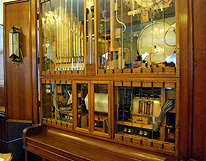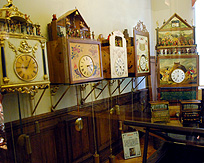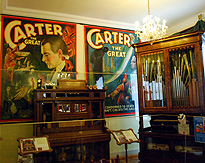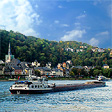WILHELMSBAU
MUSEUM - SPEYER
Music Boxes, Military Uniforms, Toys and Fashion
 If
England has its Victorian era, Germany has the Wilhelminian Period
(Wilhelmsbau) from late 19th Century to the end of First World War.
The Wilhelmsbau Museum takes its name from the last German Kaiser Wilhelm
II, and the three decade the period of his reign from 1888 to 1918.
The Museum Wilhelmsbau is part of the Technik Museum experience in
Speyer, with one of the world’s largest collection of mechanized
musical instruments, from the miniscule miniature music box up to the
china cabinet sized “orchestrion”. The instruments on display
in the historic building reach from the beginning of the music boxes
and flute clocks of the 1700s up to the player pianos and automatic
violins of the 1920s, set in richly furnished rooms of parquet flooring
and wainscoting giving the visitor the sense of the elegant lifestyle
epoch in which these marvels were at their height of popularity. The
museum’s full collections include Mechanical Music Boxes, Historic
Clothes, Military Uniforms and Weapons, Puppets and Toys.
If
England has its Victorian era, Germany has the Wilhelminian Period
(Wilhelmsbau) from late 19th Century to the end of First World War.
The Wilhelmsbau Museum takes its name from the last German Kaiser Wilhelm
II, and the three decade the period of his reign from 1888 to 1918.
The Museum Wilhelmsbau is part of the Technik Museum experience in
Speyer, with one of the world’s largest collection of mechanized
musical instruments, from the miniscule miniature music box up to the
china cabinet sized “orchestrion”. The instruments on display
in the historic building reach from the beginning of the music boxes
and flute clocks of the 1700s up to the player pianos and automatic
violins of the 1920s, set in richly furnished rooms of parquet flooring
and wainscoting giving the visitor the sense of the elegant lifestyle
epoch in which these marvels were at their height of popularity. The
museum’s full collections include Mechanical Music Boxes, Historic
Clothes, Military Uniforms and Weapons, Puppets and Toys.
Musical Clocks and Flute Instruments
 The first genuine automatic musical instruments were the musical movements
built into clocks, chimes or harp clocks, operated by the clock mechanism,
but able to play only very simple melodies. In the 18th century, the Serinette,
also commonly called a “bird organs”, became quite popular. Driving
by a hand crank these automatic musical instruments with a barrel or raised
pins would open valves of air into a pipe, imitating the whistle of a bird.
Refinement of this concept led to flute-playing clocks driven by weights. The
great famous composers like Mozart, Händel, Haydn and Beethoven all wrote
music just for these flute-playing clocks collected in the great palaces of
royals.
The first genuine automatic musical instruments were the musical movements
built into clocks, chimes or harp clocks, operated by the clock mechanism,
but able to play only very simple melodies. In the 18th century, the Serinette,
also commonly called a “bird organs”, became quite popular. Driving
by a hand crank these automatic musical instruments with a barrel or raised
pins would open valves of air into a pipe, imitating the whistle of a bird.
Refinement of this concept led to flute-playing clocks driven by weights. The
great famous composers like Mozart, Händel, Haydn and Beethoven all wrote
music just for these flute-playing clocks collected in the great palaces of
royals.
Music Boxes, Disc Boxes and Musical Movements
 The metal comb as device for sound was invented around 1796 by Antoine Favre
a Swiss clock maker in Geneva (see Patek
Philippe Museum).
After clocks the idea was transferred to the music box, with every increasing
complexity and beautiful elegant designs.
A music box industry grew in Switzerland, closely associated with the form,
but spread to other countries. In addition to the metal comb many music boxes
also feature other sound sources like little drums, bells or reeds. The largest
pinned drum could have tens of thousands of pins but could play a limited repertoire.
The invention of the metal disc which could be replaced and each with a different
tune, and which could be made cheaply began to replace the old music box.
The metal comb as device for sound was invented around 1796 by Antoine Favre
a Swiss clock maker in Geneva (see Patek
Philippe Museum).
After clocks the idea was transferred to the music box, with every increasing
complexity and beautiful elegant designs.
A music box industry grew in Switzerland, closely associated with the form,
but spread to other countries. In addition to the metal comb many music boxes
also feature other sound sources like little drums, bells or reeds. The largest
pinned drum could have tens of thousands of pins but could play a limited repertoire.
The invention of the metal disc which could be replaced and each with a different
tune, and which could be made cheaply began to replace the old music box.
Military Uniforms and Badges - The Winkler Collection
The era of the Emperor Wilhelm when the mechanical music box and auto instrument were most popular was strongly influenced by the Prussian militarism which lead inexorably to the Great War and downfall of the German Empire. The Wilhemsbau features a unique collection of historic crisp military uniforms, elaborate insignia, spiked helmets, weapons and medals of the armies of Wurttemberg and Prussia collected by the German industrialist Erwin Winkler and his wife Frida.
Toys and Dolls
The Wilhelmsbau Museum has an extensive treasure trove of antique toys, dolls and puppets. Displayed in rooms of treats for toy lovers in themes with thousands of specimens from classic porcelain dolls to fairy tale figures from the collection on loan from the Schütt Family with many of the dolls from the United States. Aside from the varied styles of and period toys dolls are a collection of railway models and steam engines, but no operating track.
Visiting the Museum Wilhelmsbau
The museum is open every day from 11am to 6pm. Admission is included with entrance to the Speyer Technick Museum (see Speyer Technic Museum). © Bargain Travel Europe
Find best hotel and travel deals on the Rhineland on TripAdvisor
Web Info
Technik
Museum Speyer
These articles are copyrighted and the sole property of Bargain Travel Europe and WLPV, LLC. and may not be copied or reprinted without permission.
See Also:
SPEYER CATHEDRAL - EMPEROR'S CHURCH
MUSEUMS OF THE DRESDEN ZWINGER SEMPERBAU
KAISER WILHELM MEMORIAL CHURCH - BLAUKIRCHE
HOHENZOLLERN CASTLE - KAISER WILHELM'S FAMILY TREE
SIEGFRIED'S MECHANICAL MUSIC BOX - RUDESHEIM
GRASSI MUSICAL INSTRUMENT MUSEUM


